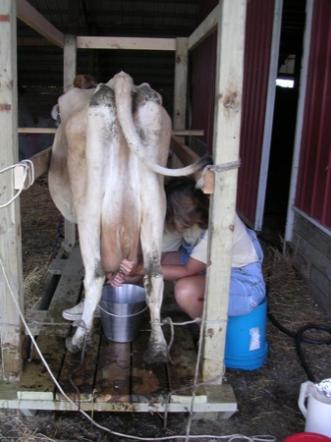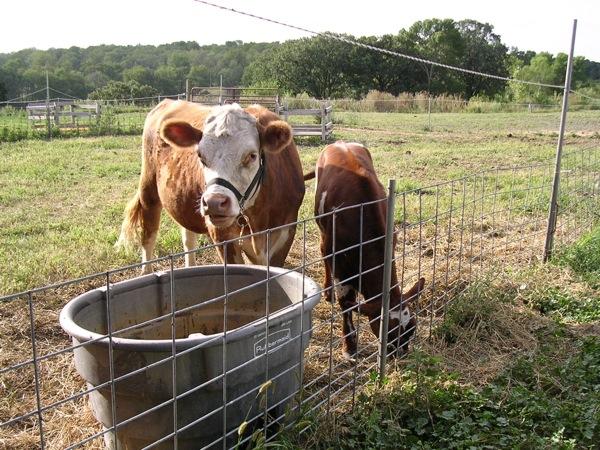Be careful what you wish for. Sometimes that’s the prime thought in my mind, especially when I’m staring at a bushel basket of carrots and the prospect of a day of canning ahead of me when I’d much rather be doing ANYTHING else. Well, this is what I wished for and dreamed about for years, and for the most part, I am not sorry I made the decision to move from the suburbs to the country.
The decision to move to the country involved many factors. My husband and I wanted to produce most of our own food, controlling the inputs (chemicals), raising our own meat humanely, and being stewards to the land that gave us all of these good things. It started with reading Five Acres and Independence by M.G. Kains which lead to subscribing to small farms magazines. Then there were more inspirational books by Wendell Berry, Lynn Byczynski , Barbara Kingsolver and Joel Salatin. Our goal was to live off the grid in Montana…we made it to Minnesota (hey, they both start with an “M”) and although not off the grid, we do produce much of what we eat and try to buy locally when we can.
Our plan, once we moved to the country was to start small. Coming from the suburbs, and never raising anything larger than a schnauzer, I figured chickens would be a good first choice. They’re small and manageable, and they can’t kill you if they get out of control. However, soon after arriving, a young jersey heifer was posted for sale and for my 41st birthday, I got my first milk cow. Now, leading and training a nervous, bred heifer is not an innate skill, and we learned quickly that holding on tight to a fleeing cow is probably not the best strategy. (Gravel burns and being taken for a drag are funny in retrospect, but at the time, not so much.)
 Robin and EsmereldaHer name was Esmeralda, and I loved her dearly. She calved in early summer, a fine bull calf we named Djali Beefsteak. (All our meat animals have meat names to keep in mind the ultimate fate of the livestock.) She would spend her days with her calf, and then at night they would be penned separately, so she would have ample milk the following morning. For several years we had 2 gallons of fresh milk daily from spring to fall, and all the cream we could possibly use. I hand milked her, leaning my head against her warm side, and sang softly as the milk filled the bucket. I became adept at avoiding her manure soaked tail and squirting milk into the mouths of mewing barn cats.
Robin and EsmereldaHer name was Esmeralda, and I loved her dearly. She calved in early summer, a fine bull calf we named Djali Beefsteak. (All our meat animals have meat names to keep in mind the ultimate fate of the livestock.) She would spend her days with her calf, and then at night they would be penned separately, so she would have ample milk the following morning. For several years we had 2 gallons of fresh milk daily from spring to fall, and all the cream we could possibly use. I hand milked her, leaning my head against her warm side, and sang softly as the milk filled the bucket. I became adept at avoiding her manure soaked tail and squirting milk into the mouths of mewing barn cats.
Of course, this idyllic picture isn’t the whole truth. She could be a regal pain-in-the-you-know-where. I have sustained my share of bruises (a cow’s hoof leaves a perfect heart shaped bruise on human flesh when impact occurs at just the right angle) and our neighbors, all born and bred dairy farmers have, I am sure, chuckled at the “city kids’” inexperience in cow handling. Fortunately, these neighbors were always willing to answer any questions I had, no matter how dumb, and came at a moment’s notice when I had concerns.
So, we had our first success raising grassfed beef (Djali and Kobe came from Esmeralda through Artificial Insemination) and then moved on to a Galloway bull and two bred Galloway cows. (Another lesson learned: go for artificial insemination, don’t get a bull. Even the nicest are aggressive, and they are BIG animals. Definitely not worth the risk.) We have produced and consumed our own grassfed beef for the last 8 years. We sold our cattle several years ago, and only now are having to purchase beef from a local producer.
In the end, the cost of raising beef was small. We had the land, the pasture, the barn space, and so only had to purchase hay for the winter. (High quality alfalfa hay is key to successful milk/beef production.) Our local meat market processes and stores our meat at a reasonable price, and we’re eating smarter. Grassfed beef tends to be much lower in fat than traditional grain fed beef and therefore, fewer calories. Grassfed beef also contains higher levels of Omega-3 fatty acids than grain fed beef, which can reduce the risk of heart attack and high blood pressure. I also think that grassfed is the tastiest beef I have ever eaten. Tasty! Healthy! I can’t go back to grain fed now.
Family Favorite Smothered Beef
Four portions Tenderized Beef Round Steak
Oil for sautéing
Flour, Salt, Pepper, Seasoning
2 Cups sliced Mushrooms
½ C sliced Onion
½ C sliced Carrot
¼ Cup Sliced Celery
1 C chopped Tomato
1 cup sliced Green pepper
Sliced fresh Garlic (I use many cloves, as much as a full head.)
Oregano, Basil, Marjoram
In a large skillet, heat the oil and sauté mushrooms, onions, carrots, and celery until soft and onions are translucent. Add tomatoes, peppers, fresh garlic and herbs. Cover and cook until green pepper has softened, and garlic has sweetened
While vegetables are cooking, dredge meat in flour, salt, pepper mixture. Heat oil in large skillet. Sauté beef steak until cooked to desired doneness. (I generally flip the meat once blood beads on the top.)
Serve vegetable mixture on top of beef. Enjoy with a glass of local red wine.
“The thought of the good pasture and of the calf contentedly grazing flavors the steak. Some, I know, will think this bloodthirsty or worse to eat a fellow creature you have known all its life. On the contrary, I think it means that you eat with understanding and with gratitude. A significant part of the pleasure of eating is in one's accurate consciousness of the lives and the world from which food comes.”
~Wendell Berry, “The Art of the Commonplace”, Counterpoint Publishing, 2003
 Robin Trott grew up in the suburbs of Baltimore, MD and dreamed of the country life. These dreams came true on the eve of her 40thbirthday. Along with her three daughters and husband, she packed up her things and moved to rural west central Minnesota. The years following this major life move have been full of new experiences: raising pigs, poultry, cattle and horses; cut flower production, market gardening, harvesting and preserving food, and living a simple life (read: really, really hard work!). The rewards of the fresh air, good neighbors, clear night skies, and home grown produce and meat are well worth all the sweat and tears put into the farm. She is a devoted “sustainable” farmer, educator, and local food advocate. Her last article for SGT was Celebrating Squash at Prairie Garden Farm.
Robin Trott grew up in the suburbs of Baltimore, MD and dreamed of the country life. These dreams came true on the eve of her 40thbirthday. Along with her three daughters and husband, she packed up her things and moved to rural west central Minnesota. The years following this major life move have been full of new experiences: raising pigs, poultry, cattle and horses; cut flower production, market gardening, harvesting and preserving food, and living a simple life (read: really, really hard work!). The rewards of the fresh air, good neighbors, clear night skies, and home grown produce and meat are well worth all the sweat and tears put into the farm. She is a devoted “sustainable” farmer, educator, and local food advocate. Her last article for SGT was Celebrating Squash at Prairie Garden Farm.




